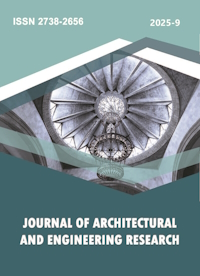On the Geometric Aspects of Architectural Compositions
DOI:
https://doi.org/10.54338/27382656-2025.9-06Keywords:
Non-Euclidian Geometry, Architecture, Poincaré model, Fractal, PsychologyAbstract
We consider different aspects of the application of non-Euclidean geometries in architectural compositions. The main attention is put on Lobachevski's and Mandelbrot's fractal geometry. Lobachevski's geometry is indirectly applied to architecture through models such as the Poincaré disc model. Using them, architects can design complex non-Euclidean forms that are represented as concave or saddle-shaped in modern buildings. The ideas of fractal geometry have been increasingly used in architectural compositions since the last decade of the 20th century. It has been noted that if the fractal component of an architectural structure is clearly traced, then this structure has strong architectural aesthetics. Many famous architectural compositions were studied on the subject of the application of non-Euclidean geometry and the level of their fractality. However, these questions have not been considered for Armenian architecture. The current paper is devoted to filling this gap and to drawing the attention of contemporary architects to the subject.
Downloads
References
A. Nahapetyan, Euclidean Interpretations of Non-Euclidean Geometry. Poincaré Model. "Quantum" College, Yerevan, 2022 (unpublished manuscript).
A. Nahapetyan, Fractal Geometry and Quantitative Evaluation of the Aesthetic Appeal of Ancient Armenian Architecture Monuments. Mathematical Problems of Computer Science, 63, 2025, 42-53. Doi: https://doi.org/10.51408/1963-0130
A. Nahapetyan, Elements of Fractal Geometry in Armenian Architectural Compositions. Mathematics (NAS RA), 2025 (in press).
R. Courant, H. Robbins, What is Mathematics? An Elementary Approach to Ideas and Methods. Oxford University Press, 2nd ed., 1996.
B.F. Kagan, Osnovy geometrii. Gostekhizdat, 1949 (in Russian).
D. Marshall, P. Scott, A Brief History of Non-Euclidean Geometry. The Australian Mathematics Teacher, 60 (3), 2004, 2-4.
V.V. Prasolov, Geometriya Lobachevskogo. MCCME, Moscow, 3rd ed., 2004 (in Russian).
B.B. Mandelbrot, The Fractal Geometry of Nature. W.H. Freeman and co., San Francisco, 1982.
R.M. Crownover, Introduction to Fractals and Chaos. Jones and Bartlett Publishers, 1995.
J. Feder, Fractals. Plenum Press, New York, 1988.
N.A. Salingaros, Architecture, Patterns, and Mathematics. Nexus Network Journal, 1, 1999, 75-86.Doi: https://doi.org/10.1007/s00004-998-0006-0
W. E. Lorenz, Fractals and Fractal Architecture: PhD thesis, Vienna University of Technology, 2003.
C. Bovill, Fractal Geometry in Architecture and Design, Birkhäuser, 1996.
J.C. Sprott, Strange Attractors: Creating Patterns in Chaos. M&T Books, New York, 1993.
R.P. Taylor, Reduction of Physiological Stress Using Fractal Art and Architecture. Leonardo, 39 (3), 2006, 245-251.
S.D. Pyankova, Fraktalno-analiticheskiye issledovaniya v psikhologii: osobennosti vospriyatiya samopodobnykh obyektov. Psychological Studies, 9 (46), 2016 (in Russian). Doi: https://doi.org/10.54359/ps.v9i46.484
S.D. Pyankova, Subyektivnyye otsenki vizualnoy slozhnosti i esteticheskoy privlekatelnosti fraktalnykh izobrazheniy: individualnyye razlichiya i geneticheskiye vliyaniya. Psikhologicheskiye issledovaniya, 12 (63), 2019 (in Russian). Doi: https://doi.org/10.54359/ps.v12i63.238
N.A. Salingaros, Fractal Art and Architecture Reduce Physiological Stress. Journal of Biourbanism, 2 (2), 2012, 11-28.
C.M. Hagerhall, T. Purcell, R. Taylor, Fractal Dimension of Landscape Silhouette Outlines as a Predictor of Landscape Preference. Journal of Environmental Psychology, 24 (2), 2004, 247-255. Doi: https://doi.org/10.1016/j.jenvp.2003.12.004
F.I. Mavrikidi, Fraktalnaya matematika i priroda peremen. Delphis, 54 (2), 2008 (in Russian).
P.K. Acharya, An encyclopaedia of Hindu architecture (vol.7). Oxford University Press, London, 1946.
H.D.A. Ismail, Fractal analysis of masterpieces of Islamic architecture – The Mosque of Ahmad Shah and Taj Mahal: justification of the method and experience of application (in Russian). Architecture and Modern Information Technologies, 4 (21), 2012 (in Russian).
H.D.A. Ismail, M.Yu. Shishin, Application of a Multi-Stage Fractal Method in Analysis Masterpieces of Islamic Architecture – Ahmad Shah Mosque. Art of Eurasia, 3 (10), 2018, 37-47 (in Ruassin). Doi: https://doi.org/10.25712/ASTU.2518-7767.2018.03.003
I.A. Mayatskaya, G.I. Fazylzyanova, B M. Yazyev, S.B. Yazyeva, Fraktalnost goticheskoy arkhitektury. Engineering Journal of Don, 4, 2025 (in Ruassin).
J. Strzygowski, Die Baukunst der Armenier und Europa: Ergebnisse einer vom Kunsthistorischen Institute der Universitat Wien 1913 durchgefuhrten Forschungsreise. Kunstverlag Anton Schroll & Co., 1918.
Downloads
Published
How to Cite
Issue
Section
License
Copyright (c) 2025 Aren Nahapetyan, Linda Khachatryan

This work is licensed under a Creative Commons Attribution-NonCommercial 4.0 International License.
Creative Commons Attribution-Non-Commercial (CC BY-NC). CC BY-NC allows users to copy and distribute the article, provided this is not done for commercial purposes. The users may adapt – remix, transform, and build upon the material giving appropriate credit, providing a link to the license. The full details of the license are available at https://creativecommons.org/licenses/by-nc/4.0/.













